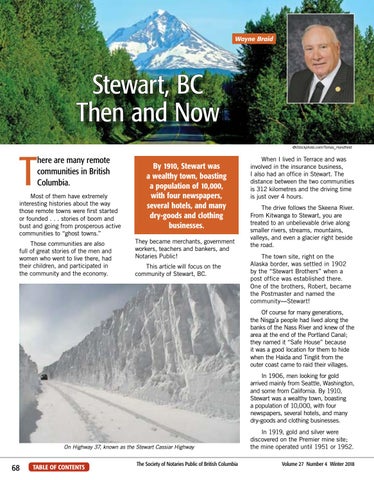Wayne Braid
Stewart, BC Then and Now
T
©iStockphoto.com/Tomas_Handfield
here are many remote communities in British Columbia.
Most of them have extremely interesting histories about the way those remote towns were first started or founded . . . stories of boom and bust and going from prosperous active communities to “ghost towns.” Those communities are also full of great stories of the men and women who went to live there, had their children, and participated in the community and the economy.
By 1910, Stewart was a wealthy town, boasting a population of 10,000, with four newspapers, several hotels, and many dry-goods and clothing businesses. They became merchants, government workers, teachers and bankers, and Notaries Public! This article will focus on the community of Stewart, BC.
When I lived in Terrace and was involved in the insurance business, I also had an office in Stewart. The distance between the two communities is 312 kilometres and the driving time is just over 4 hours. The drive follows the Skeena River. From Kitwanga to Stewart, you are treated to an unbelievable drive along smaller rivers, streams, mountains, valleys, and even a glacier right beside the road. The town site, right on the Alaska border, was settled in 1902 by the “Stewart Brothers” when a post office was established there. One of the brothers, Robert, became the Postmaster and named the community—Stewart! Of course for many generations, the Nisga’a people had lived along the banks of the Nass River and knew of the area at the end of the Portland Canal; they named it “Safe House” because it was a good location for them to hide when the Haida and Tinglit from the outer coast came to raid their villages. In 1906, men looking for gold arrived mainly from Seattle, Washington, and some from California. By 1910, Stewart was a wealthy town, boasting a population of 10,000, with four newspapers, several hotels, and many dry-goods and clothing businesses.
On Highway 37, known as the Stewart Cassiar Highway
68
TABLE OF CONTENTS
The Society of Notaries Public of British Columbia
In 1919, gold and silver were discovered on the Premier mine site; the mine operated until 1951 or 1952. Volume 27 Number 4 Winter 2018


























